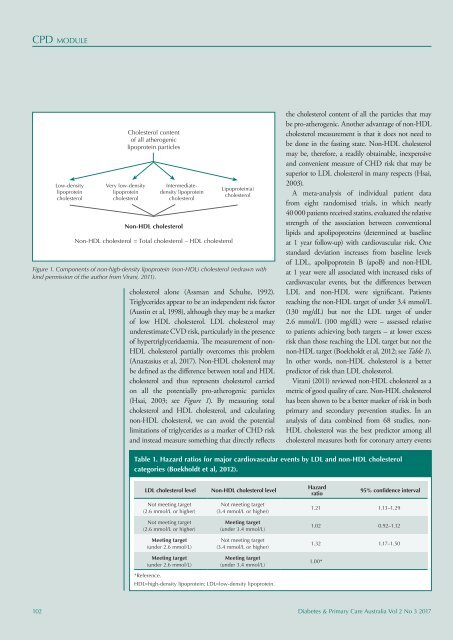DPCA 2-3_100-110
Create successful ePaper yourself
Turn your PDF publications into a flip-book with our unique Google optimized e-Paper software.
CPD module<br />
Low-density<br />
lipoprotein<br />
cholesterol<br />
Very low-density<br />
lipoprotein<br />
cholesterol<br />
Cholesterol content<br />
of all atherogenic<br />
lipoprotein particles<br />
Intermediatedensity<br />
lipoprotein<br />
cholesterol<br />
Non-HDL cholesterol<br />
Non-HDL cholesterol = Total cholesterol – HDL cholesterol<br />
Lipoprotein(a)<br />
cholesterol<br />
Figure 1. Components of non-high-density lipoprotein (non-HDL) cholesterol (redrawn with<br />
kind permission of the author from Virani, 2011).<br />
cholesterol alone (Assman and Schulte, 1992).<br />
Triglycerides appear to be an independent risk factor<br />
(Austin et al, 1998), although they may be a marker<br />
of low HDL cholesterol. LDL cholesterol may<br />
underestimate CVD risk, particularly in the presence<br />
of hypertriglyceridaemia. The measurement of non-<br />
HDL cholesterol partially overcomes this problem<br />
(Anastasius et al, 2017). Non-HDL cholesterol may<br />
be defined as the difference between total and HDL<br />
cholesterol and thus represents cholesterol carried<br />
on all the potentially pro-atherogenic particles<br />
(Hsai, 2003; see Figure 1). By measuring total<br />
cholesterol and HDL cholesterol, and calculating<br />
non-HDL cholesterol, we can avoid the potential<br />
limitations of triglycerides as a marker of CHD risk<br />
and instead measure something that directly reflects<br />
the cholesterol content of all the particles that may<br />
be pro-atherogenic. Another advantage of non-HDL<br />
cholesterol measurement is that it does not need to<br />
be done in the fasting state. Non-HDL cholesterol<br />
may be, therefore, a readily obtainable, inexpensive<br />
and convenient measure of CHD risk that may be<br />
superior to LDL cholesterol in many respects (Hsai,<br />
2003).<br />
A meta-analysis of individual patient data<br />
from eight randomised trials, in which nearly<br />
40 000 patients received statins, evaluated the relative<br />
strength of the association between conventional<br />
lipids and apolipoproteins (determined at baseline<br />
at 1 year follow-up) with cardiovascular risk. One<br />
standard deviation increases from baseline levels<br />
of LDL, apolipoprotein B (apoB) and non-HDL<br />
at 1 year were all associated with increased risks of<br />
cardiovascular events, but the differences between<br />
LDL and non-HDL were significant. Patients<br />
reaching the non-HDL target of under 3.4 mmol/L<br />
(130 mg/dL) but not the LDL target of under<br />
2.6 mmol/L (<strong>100</strong> mg/dL) were – assessed relative<br />
to patients achieving both targets – at lower excess<br />
risk than those reaching the LDL target but not the<br />
non-HDL target (Boekholdt et al, 2012; see Table 1).<br />
In other words, non-HDL cholesterol is a better<br />
predictor of risk than LDL cholesterol.<br />
Virani (2011) reviewed non-HDL cholesterol as a<br />
metric of good quality of care. Non-HDL cholesterol<br />
has been shown to be a better marker of risk in both<br />
primary and secondary prevention studies. In an<br />
analysis of data combined from 68 studies, non-<br />
HDL cholesterol was the best predictor among all<br />
cholesterol measures both for coronary artery events<br />
Table 1. Hazard ratios for major cardiovascular events by LDL and non-HDL cholesterol<br />
categories (Boekholdt et al, 2012).<br />
LDL cholesterol level<br />
Non-HDL cholesterol level<br />
Hazard<br />
ratio<br />
95% confidence interval<br />
Not meeting target<br />
(2.6 mmol/L or higher)<br />
Not meeting target<br />
(2.6 mmol/L or higher)<br />
Meeting target<br />
(under 2.6 mmol/L)<br />
Not meeting target<br />
(3.4 mmol/L or higher)<br />
Meeting target<br />
(under 3.4 mmol/L)<br />
Not meeting target<br />
(3.4 mmol/L or higher)<br />
1.21 1.13–1.29<br />
1.02 0.92–1.12<br />
1.32 1.17–1.50<br />
Meeting target<br />
(under 2.6 mmol/L)<br />
*Reference.<br />
Meeting target<br />
(under 3.4 mmol/L)<br />
HDL=high-density lipoprotein; LDL=low-density lipoprotein.<br />
1.00*<br />
102 Diabetes & Primary Care Australia Vol 2 No 3 2017
















